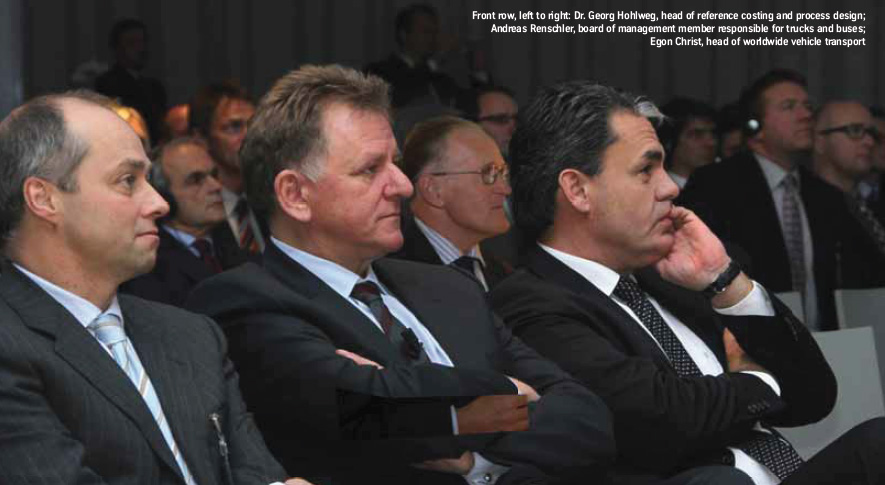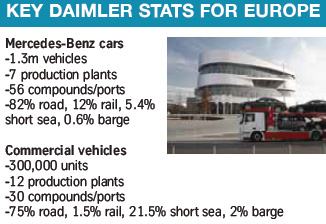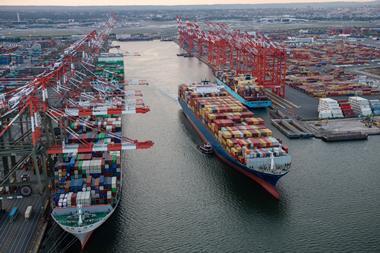
Daimler’s 11th annual European Carrier Day came at a time when the carmaker is accelerating globally in sales and logistics development, and often well ahead of its many vehicle logistics providers in Europe. Christopher Ludwig reports from Stuttgart.
While 2010 marked a decade since Daimler’s first European Carrier Day–a gathering of more than 100 vehicle logistics partners to award the best performance in passenger car and commercial vehicle logistics–the most recent event could be called the first ‘post-crisis’ Carrier Day.
While Daimler held a pared-down awards ceremony in 2009, 2010 was a return to form, with an evening dinner and a full day of management presentations on strategy and tenders at its headquarters in Stuttgart. But the programme also showed an evolution from past events. Firstly, external and Daimler speakers focused more on economic forecasts than in the past, which highlighted the strengthening outlook for the German premium brands. However, there was also attention paid to risks, from the European sovereign debt crisis to potential currency wars. There was a signal that ‘crisis mode’ had not entirely been switched off, even though Daimler has swung back to remarkable profitability, forecasted to top €7 billion ($9.2 billion) for 2010; in 2009 it lost nearly €2 billion. But Dr Holger Scherr, head of worldwide transport logistics, told providers that such profits would not result in outright higher spending, and that Daimler must find more efficiencies, including for logistics, if its manufacturing is to remain competitive in Europe. “The crisis is not over,” he said. “We have all suffered, and will probably continue to suffer.”


The event also had a more global focus. That included the growth for Daimler cars and trucks in Russia and Turkey, as well as overseas markets such as the USA and especially China, where in 2010 Daimler will have sold more than 115,000 vehicles–about 80,000 of which are vehicle imports from Germany–and which has been the company’s most important source of growth. The unexpected surge in China and recovery in other markets has kept demand in the supply chain, as German light vehicle exports surpass pre-crisis levels, on pace to reach about 4.15m vehicles (versus 3.4m in 2009) according to Marius Baader, head of forecasting for the VDA. The export surge comes as the German market has declined around 25% following the end of trade-in incentives, and other Western European markets have also fallen by double digits. To handle this global shift, Daimler has put in place a new international projects team within its vehicle logistics structure. Daimler will also integrate global brands and alliances into its network, including Fuso and other commercial vehicles, and new alliance partner Renault Nissan for cross manufacturing and other potential opportunities. For China, it will integrate distribution into the central planning and purchasing team, switching from a pull model (where dealers took responsibility for vehicles at ports of arrival) to a push system, where Daimler takes control to the final dealer for both imports and Chinese-produced Mercedes.
A growing gap among logistics providers
But this growth and integration globally also signifies the twospeed recovery in Europe, which has further divided the gap in fortunes of logistics providers. In an anonymous, electronic survey at the event, only 3% of providers polled claimed to be profitable, with 60% saying they’re losing money–although the follow-up question, a tongue-in-cheek query about how honest providers were about profit–suggested 20% or more were exaggerating their plight.
Nevertheless, a fragmented vehicle logistics industry is becoming even more so, as providers supporting carmakers on their international flows, processing, shipping, IT track and trace or other global services have benefited, while regional providers serving only Germany or parts of Europe have found it tough. On the sidelines of the event, carriers talked about the likelihood of consolidation among providers. Such is the impact the economy has had on carriers that Daimler’s comprehensive KPI monitoring system–the foundation on which the awards are based–has revealed a decline in performance metrics for the first time. The average performance for passenger cars has now fallen below 70 (out of 100), which is the baseline for Daimler’s performancerelated- pay (PRP) system (see boxout on p30), and is also lower than commercial vehicle logistics for the first time. Egon Christ, head of worldwide vehicle logistics, says the primary reason for this decline is the imbalance in flows, particularly between imports, exports and domestic distribution. “In 2009, the scrappage incentives led to an influx of cheap imports in Europe, with few exports, while in 2010 it has been the opposite,” he said.
 But other reasons could also be related to the difficulty faced by carriers in the sector, many of whom continue to feel the strain of cost pressure and weak volume.
But other reasons could also be related to the difficulty faced by carriers in the sector, many of whom continue to feel the strain of cost pressure and weak volume.
The great capacity debate resumes
Christ pointed to a potential lack of truck capacity in the European market, a scenario that could worsen should Daimler’s sales grow as anticipated. While he acknowledged the necessity of capacity cuts during the crisis, Christ renewed calls for investment. “Assume your responsibility as partners to Daimler and invest,” he said. “It will be needed.” While rail and sea capacity were deemed sufficient, such calls for truck investment brought to mind the debates for more capacity prior to the collapse of 2008. The subsequent capacity glut has no doubt left carriers feeling burned. The survey revealed that 54% of the audience planned to maintain current capacity levels in 2011, while 16% planned cuts and only 30% would expand fleets.
Daimler’s call for more capacity sounds justified if current forecasts are to be trusted. The new year should bring continued export growth to China and other emerging markets, US recovery of around 10%, and a slow climb back for Europe, with 9% in Eastern Europe and 2% in Western Europe, according to Daimler analysts and the VDA. Russian growth, more than 20% in 2010, should slow in 2011 but stay positive. Carriers too acknowledged the potential shortage for 2011, with the survey revealing that 66% believe demand would be higher than available road transport in 2011. Yet carriers may simply be unable to keep up. Financing is difficult, while commodity prices have risen at a greater pace than economic recovery. Barbera Renner, a Daimler economist, said crude oil has hit levels that make operations difficult for logistics providers in the current economy. Christ told carriers that he felt their pain. “I understand your problems, including overcapacity, tough competition, difficult financing and network efficiency issues,” he said. He admitted that had it not been for the incentive programmes by European governments, “a number of tables in the room today would be empty”.
Such understanding was, in principle, encouraging to providers. Several at the event told Finished Vehicle Logistics that Daimler is a considerably better partner than other carmakers. One pointed out how Daimler generally has contracts of at least two years, compared to one-year contracts common among others. Daimler also has a fuel-clause policy, which gives rebates in line with changes. The company is now harmonising this fuel clause across both its passenger car and commercial vehicle partners. But there is mistrust, nonetheless. In the survey Daimler asked whether carriers thought it was a trustworthy partner–60% answered that it wasn’t.
Some carriers were disappointed, for example, with Daimler’s insistence that they use Daimler brand trucks to serve its commercial vehicles. Christ said that in some instances he had counted plant pick-ups where 13 out of 15 trucks were from other brands. “Our board members are noticing this trend, and they have thin patience,” he said. “We expect loyalty and expect you to use our trucks.” But one carrier said that if it used only the brand names of its customers, the networks would never be efficient, as empty trucks in the same area would not be able to pickup return loads simply because it had the wrong badge.
The mistrust was not only on the provider’s side, however. Daimler expressed unease that capacity shortages might be caused deliberately, referring to a speech made at the ECG Conference in Berlin that proclaimed such a shortage would benefit carriers by driving up rates (see p16). But Christ warned that carriers suspected of engaging in such practices would lose business. “You [carriers] can find a better recipe to improve your businesses than withholding capacity,” he said.
A time of tender opportunity
When Christ called 2010 and 2011 “a time of opportunity”, he did not mean it figuratively. Daimler tendered an immense swath of volumes in 2010, including 519,000 passenger cars and 178,500 commercial vehicles in Europe, 104,400 cars and vans in the US, 80,000 imports to China as well as volume in Japan, South Africa and elsewhere. There were also significant volume put out for ro-ro transport–in which Daimler now bundles together cars and commercial vehicles in tenders– including 160,000 vehicles on the Atlantic and Oceania trade, as well as 37,000 vehicles from South Africa. Around 4,000 vehicles in containers were also tendered. Daimler has significant tenders for 2011 as well. A large focus will be on Central and Eastern Europe, where Daimler will sign up providers for its new plant in Hungary, which starts production in early 2012. For commercial vehicles, there will be a tender for vans in Eastern Europe, and one for around 62,000 heavy trucks from Daimler’s factories in Wörth, Germany and in Turkey.
For 2011, there will also be car and commercial vehicle tenders in the UK and France. Daimler will also investigate further how to integrate providers with Renault Nissan. Overseas, Christ revealed a capacity realignment in the US, including dealer expansion, for car sales growth of around 10% and van sales of 50%. Daimler will further integrate its commercial vehicle brands into the same network across the NAFTA region.
In China, Daimler will take control of its entire distribution chain in China to the dealers, as mentioned. This strategic centralisation, which will allow Daimler to better manage its growth in the country, will also include distribution from vehicle processing centres and local production with jointventure partner, Beijing Automotive.
Growth at sea
On the ocean side, growth in Asia has made Daimler a formidable global shipper. Two years ago its imports to China were shipped in container; now they move there by ro-ro, as well as to markets such as South Korea and Malaysia. While it does not yet use ro-ro for India (where there are much fewer imports than China), Thomas Banholzer, responsible for overseas shipping of passenger cars and commercial vehicles, told Finished Vehicle Logistics that Daimler was currently investigating the switch with shipping lines.
Daimler is introducing more competition into its selection of ocean carriers and ports, including its plans for a PRP scheme. Unlike the trucking sector, where Daimler has more than 100 partners, ocean transport has about seven providers. Likewise, service is less flexible, often tied to ports, with commitments needed many weeks in advance. Banholzer said Daimler wants to build a network with “flexible ports of exit”. In recognising that 20-30% of costs for shipping vehicles by ocean is related to loading, Daimler wants to engineer more flexibility at ports. In future, rather than concentrating all Atlantic exports to Bremerhaven, Daimler wants to be able to choose between Bremerhaven and Zeebrugge, diverting shipments when necessary because of delays or constraints. Daimler also wants flexibility between carriers for excess capacity. Banholzer said that Daimer would track ocean volume a month ahead; for excess volume, it will check first with contracted carriers, but will then tender it to others. In other areas, Daimler has tried to build competition in the market. For exports from South Africa to the US, for example, ships usually sailed via Bremerhaven, adding weeks to final delivery. Daimler explored shipping cars in containers for direct moves. “We developed a viable option to ro-ro, but it was not implemented,” said Banholzer. However, a new ro-ro agreement was secured until 2013, this time going direct to the US. “The container option created competition,” he added. Following the Atlantic, Oceania and Chinese tenders for 2010, Daimler will tender up to 90 destinations in 2011 for cars, vans, trucks and buses. The Fuso commercial vehicle brand will also be integrated into the global ro-ro shipping network. Furthermore, Daimler will rollout a lead logistics partner concept for other niche markets. Developed already for Australia and New Zealand, the LLP takes responsibility for inland logistics and supply chain management.
Getting back to green
Christ and Scherr called for more innovation. Daimler has taken several new approaches itself, including “reference costing,” in which the OEM investigates the costs of transport and logistics to understand prices.
On the carrier side, Daimler pointed to the trial of new trailer shuttles, developed with Horst Mosolf and carrierbuilder Lohr, which attach directly to trucks at pickup. The shuttle concept make it easier to build flexible loads; it also creates loading specialists separate from drivers that Daimler believes will be more efficient. Pilot operations begin in 2011. Daimler also called for a renewed focus on CO2 reduction, an area Christ believed had been put aside during the crisis. “The logistics business must ask itself, ‘can we really carry on with business as usual?’ I have seen no jolt so far.” Daimler pointed to a project that could help improve emissions and efficiency: a cross-OEM and LSP-pilot programme for RFID tracking, which will see material tracked from Bremerhaven to Daimler’s Alabama plant, with finished vehicles then tagged and tracked back to Germany. The programme, which involves tier ones such as Bosch and logistics providers such as BLG and DHL, should reveal opportunities to avoid delays and reduce waste.
Holger Scherr said that, for the trucking community, the environmental debate needed to be refocused. Rail is not always “greener” than trucks, particularly if trainloads aren’t full, he said. Scherr gave the example of the “EuroCombi”, a longer, heavier truck whose dimensions are being debated in the European Commission. While the media has portrayed them as dangerous “monster trucks”, Scherr said the industry needed to demystify that image, and explain the potential benefits, such as fewer truckloads. He came out in favour of a four tonne increase on current dimensions in Germany to 44 tonnes. “It’s an efficiency that Daimler needs,” he said.

























![Global[1]](https://d3n5uof8vony13.cloudfront.net/Pictures/web/a/d/s/global1_726550.svgz)









